The women’s luxury footwear segment, valued at USD 16.49 billion in 2025, represents roughly 10-12% of the USD 205 billion global women’s footwear market. It is projected to reach USD 25.66 billion by 2035, tracking a steady 4.6% CAGR.
Future Market Insights attributes this climb to premiumisation, the rise of capsule street-luxury collections, and a rebound in experiential retail that lets high-income consumers “try before they buy” via concierge shopping apps. Luxury brands are widening price ladders with entry-level sneakers and slides to capture Gen-Z affluence, maintaining exclusivity through limited drops and NFT-authenticated provenance.
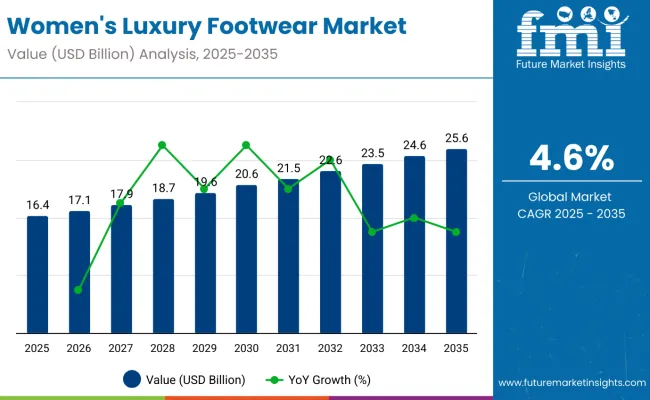
| Attribute | Details |
|---|---|
| Historical Women’s Luxury Footwear Market Size 2024 | USD 15,660.8 million |
| Estimated Women’s Luxury Footwear Market Size 2025 | USD 16.49 billion |
| Projected Women’s Luxury Footwear (2035) Market Size | USD 25.66 billion |
| Value CAGR (2025 to 2035) | 4.6% |
Asia remains the growth engine, yet shifting tourist flows are reshaping demand. “We really have a big shift of business from Asia into Japan,” LVMH CFO Jean-Jacques Guiony noted on a recent earnings call, underscoring how currency differentials and travel corridors now influence store footprints and inventory allocation. Japan’s resurgence as a luxury shopping destination has also accelerated new store openings and targeted marketing efforts in Tokyo and Osaka.
Digital resale is another tailwind-platforms such as The RealReal report double-digit gains in authenticated luxury shoes, supporting circular-fashion narratives that resonate deeply with ESG-minded buyers. This resale momentum is encouraging brands to reconsider product lifecycles, creating designs with higher resale value. Additionally, technology integrations are increasing transparency, with blockchain solutions providing consumers detailed insights into the sourcing and authenticity of footwear, further reinforcing consumer trust and driving sales growth.
Luxury houses are also placing greater emphasis on sustainability and ethical sourcing. Brands like Gucci and Stella McCartney are setting industry benchmarks by committing to traceable leather and vegan alternatives. Bespoke footwear services, once limited to ultra-high-net-worth individuals, are expanding rapidly due to digital configurators, making personalized luxury shoes accessible to broader affluent segments. Innovations such as augmented reality fittings and virtual personal stylists further elevate consumer experience, fostering deeper brand connections.
As luxury brands continuously refine their omnichannel strategies, merging digital innovation with enhanced in-store experiences, the women’s luxury footwear category is positioned for durable, experience-led growth through 2035.
Per capita spending on women’s luxury footwear is growing steadily across global markets, driven by rising disposable incomes, increasing fashion awareness, and the impact of social media and celebrity endorsements. What was once a niche category has evolved into a mainstream choice for many consumers, supported by product innovation and strong brand presence.
The global trade of women’s luxury footwear is shaped by evolving consumer preferences, brand globalization, and expanding retail networks. These high-value products are traded extensively across regions to meet demand in both established luxury markets and emerging economies. Trade flows are influenced by manufacturing hubs, brand origins, and distribution strategies that cater to fashion-conscious consumers worldwide.
The above table presents the expected CAGR for the global women’s luxury footwear market industry over several semi-annual periods from 2025 to 2035. In the first half (H1) of the decade from 2024 to 2034, the business is predicted to surge at a CAGR of 3.3%, followed by a slightly higher growth rate of 5.5% in the second half (H2) of the same decade.
| Particular | Value CAGR |
|---|---|
| H1 | 3.3% (2024 to 2034) |
| H2 | 5.5% (2024 to 2034) |
| H1 | 6.0% (2025 to 2035) |
| H2 | 3.2% (2025 to 2035) |
Moving into the subsequent period, from H1 2025 to H2 2035, the CAGR is projected to increase slightly to 6.0% in the first half and remain relatively low at 3.2% in the second half. In the first half (H1) the sector witnessed a decrease of 60 BPS while in the second half (H2), the industry witnessed an increase of 32 BPS.
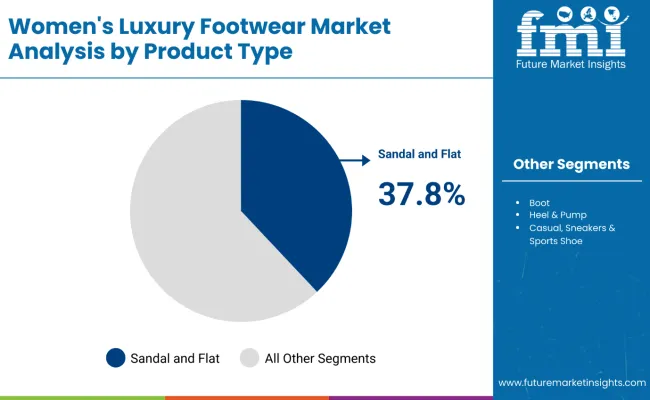
The sandals and flats segment is anticipated to dominate the women's luxury footwear market, capturing a substantial value share of 37.8% by 2025, according to Future Market Insights. This segment’s strength comes from its unique combination of comfort, versatility, and aesthetic appeal, fulfilling both casual and formal styling needs. Consumers increasingly prefer luxury footwear that seamlessly blends practicality with high-end fashion.
Brands such as Gucci, Valentino, and Chanel continue expanding their luxury flat footwear offerings, focusing on stylish designs suitable for daily wear. Additionally, innovative designs featuring premium sustainable materials further boost consumer demand, aligning with rising environmental consciousness among luxury shoppers. "Luxury footwear buyers seek comfort without compromising on elegance," remarked Patrizio Bertelli, CEO of Prada Group, highlighting ongoing consumer preference trends as per Vogue Business, 2025.
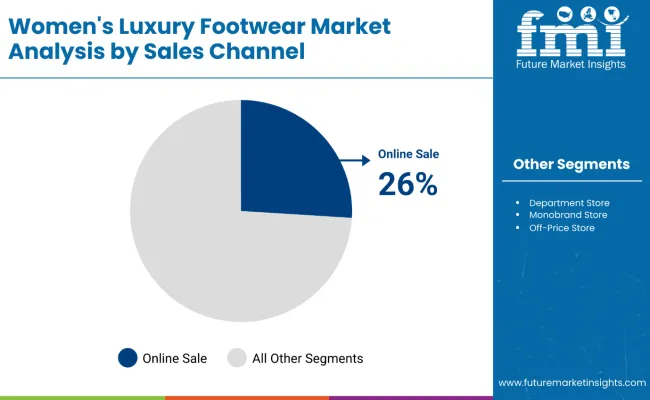
The online sales channel holds 26% of market share in 2025. Increased global smartphone penetration, widespread internet availability, and consumer preference for convenient shopping experiences contribute substantially to this expansion. Luxury brands are increasingly investing in sophisticated e-commerce platforms, offering enhanced customer interactions, personalized shopping experiences, exclusive online collections, and secure, anonymous delivery options.
Brands leverage social media collaborations, influencer endorsements, and digital marketing strategies to attract younger demographics. Websites frequently feature exclusive incentives, subscription-based loyalty programs, and digital fitting tools to elevate user experience. "Digital is central to reaching today's luxury consumers, combining exclusivity with convenience," stated Marco Gobbetti, CEO of Ferragamo, underscoring the strategic importance of online retail channels in luxury footwear distribution as per Business of Fashion, 2025.
The global industry of women's luxury footwear experienced a steady growth rate of 3.9% from 2020 to 2024, driven by factors such as increasing disposable incomes, the rise of fashion-forward consumers, and a growing desire for premium and exclusive products.
In this period, consumers looked for high-quality luxurious shoes which are considered status symbols of their fashion and were concerned with quality and brand image. Various technologies used in shoe making as well as developments in shoe design also contributed significantly in getting increased appeal of luxury shoes, which provided better comfort and style of the shoe.
Also, the growth of the internet and especially the expansion of online retail platforms and social media presence were the key factors for market growth. Businesses were able to leverage on digital promotion techniques that ensured that a large pool especially the young adult population was reached.
This trend making it extend its horizons in developing other kinds of luxury product designs that include footwear designs, differing size inclusiveness, and customization of luxury footwear products. The threat of new entrants and the introduction of limited edition product lines also strengthened the market penetration across the regions.
Looking ahead to the 2025 to 2035 period, the market is expected to maintain a robust growth trajectory, with a forecasted growth rate of 4.6%. This outlook has always been positive due to the constant developments in the type of material used in making the footwear and the designs being developed with special consideration to environmental concerns.
For example, use of recycled material, vegan leather and biodegradable parts are likely to appeal consumers who are keen on environmental issues. Due to the fact that luxury footwear is already linked to ethical fashion, there will be a gradually rising trend for brands to engage in sustainability strategies that they apply to the product.
Another consideration, which refers to the spread of the market in the emergent economies, is also possible, because increase in disposable income and changes in the preferences concerning the clothing in these countries can stimulate the demand.
Better access points and awareness of the brand will also continue to enhance the market’s growth. To sum up, women’s luxury footwear has a great potential for the further market development during the next ten years due to the advancements in the field of technology, changes in the customers’ demand, and the constantly growing interest towards the international markets.
Women’s luxury footwear industry is expected to have strong future development due to the increased demand for high-end fashion shoes and the rising tendency of ethical consumption. The desire for stylish, efficient, individualistic luxury shoes is progressing as a result of women’s fashion awareness and their need for expression through their footwear.
Also, consumers have become conscious of the styles expressed by wearing sustainable fashion that affects brand choices. These efforts not only address the market niche that concerns itself with environmentalism but also improve the brand appeal as the leader in luxury sustainable fashion.
In addition, factors such as influencer marketing and social marketing campaigns have been deemed to support the overall growth of the market. Manufacturers and designers of luxury footwear products are also using these forums to advertise their products and interact with their subscribers and fans.
This distinctive concentration on online communications should help drive the market, especially because young customers often pay attention to the latest trends within the digital world.
The modern consumer, especially the Women in the higher income group, looking forward for the decent status and classy looks, in quest of the footwear which not only have aesthetic value but also have the potential to match the lifestyle and values which such consumer embraces. This has led to the need for half shoes that exhibit quality, comfort as well as an ability to be reused.
Another factor that cannot be disfranchised is the element of ethical fashion. This need has made the consumers want to be made aware of the environmental and societal consequences of the products that they are buying thus the high demand for environmentally friendly footwear that are manufactured using environmentally friendly material. This trend is most especially observed with young consumers as they are willing to spend a little more on products that are friendly to nature.
As a consequence, the excessive use of leather by luxury shoemakers is being countered by incorporating sustainable materials and involving the latest technologies when developing their products to cater to the market requirements.
From shoes manufactured from fully biodegradable material to those that are uniquely comfortable and long-lasting, this industry is rapidly evolving in a way that meets the new, and conscious consumer.
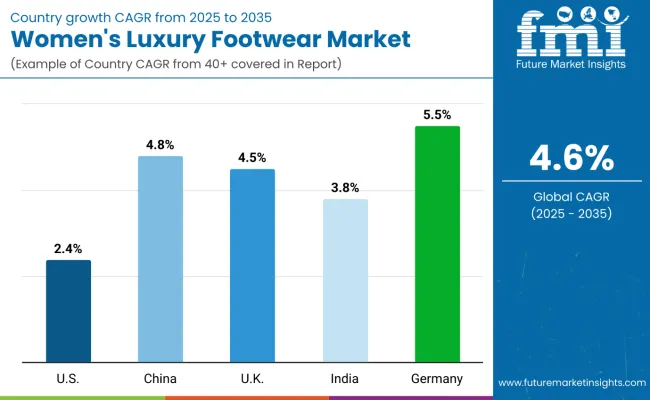
Sophisticated style and high comfort levels expected to elevate market sales in the USA
The luxury footwear market in the USA is forecasted to experience a robust CAGR of 2.4%, fueled by a growing demand for high-fashion and high-comfort footwear. American customers put great importance on both appearance and comfort when making their purchase.
Sustained technological development in introducing new advanced materials and ergonomic concepts in luxury bags and shoes has caused appeal among the highly discriminating customer base who are willing to invest in luxurious yet usable fashion statements.
Another fundamental factor driving the market is fashion about custom made and private labeled footwear since individuals need shoes that are distinct and comfortable.
Also, more companies in the USA are trying to incorporate the latest technology into their shoe design, including cushioning technology and temperature control materials to improve the consumer experience.
This technological innovation helps address the rising requirement for luxury while also addressing functionality, which is crucial to the constantly expanding use and approval of premium footwear. Consequently, luxury footwear is nowadays one of the important categories of the fashion industry that combines style with functionality for various customers.
Rising disposable incomes and shifting consumer preferences fueling luxury footwear sales
In China, the women’s luxury footwear market is forecasted to increase at a remarkable compound annual growth rate (CAGR) of 4.8% during the forecast period. This growth is attributed to the rising disposable incomes among the affluent class and a growing inclination towards high-end fashionable shoes and footwear.
Chinese consumers are targeting luxury brands that provide a rare and unique item, which is well-made and comfortable to wear. With the increase in disposable income per capita, more people are attaining branded and fashionable footwear as a sign of status symbol and fashion statement.
To address this need, luxury brands are diversifying their portfolios and improving their marketing techniques. Simple endorsements, partnerships with well-known fashion designers, and VIP product releases are becoming popular strategies to appeal to the selective Chinese clientele.
Further, there is an observed increase in the market popularity of online platforms for purchasing luxury shoes, as they offer a wider selection of products and convenient delivery to the consumer’s house. There is also an increasing trend towards the above affect as consumers try to treat themselves to luxury products even when they are not celebrating.
Efforts to increase awareness and accessibility contributing to market expansion in Africa
The luxury product focusing the footwear market in Africa is a slowly growing market having a market share of 55.7% in the East Asia region due to growing awareness and local programs. That is why there are still such problems as lack of funds, difficult conditions for the purchase of high-quality products, etc., but at the same time, there is an effective audience for the purchase of shoes.
Regional fashion designers and other luxury brands are thus trying to strengthen their market standing through the provision of the right kinds of apparels and accessories that would suit African customers.
For example, measures like luxury pop-up stores and the cooperation with local opinion leaders are well on the way to remove the distance between luxury brands on the one hand and the African market on the other hand. These also created awareness over luxury footwear as well as enhancing its availability since premium shoes are embraced to the market.
Thus, as the economic situation changes and consumers pays more attention to quality, comfort and style, the African market for luxury footwear has room to develop and new opportunities for brands to appear.
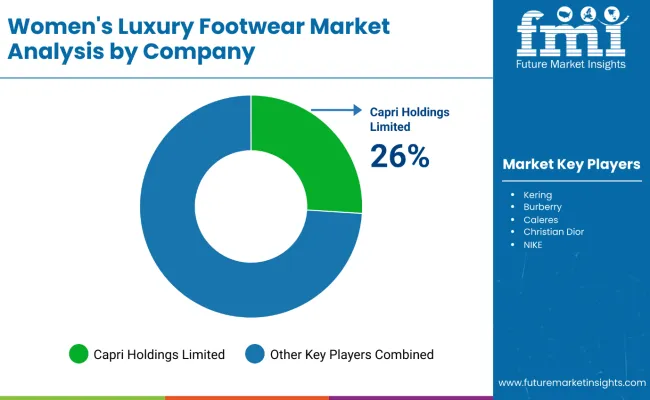
The women’s luxury footwear market is highly competitive, led by major players like LVMH, Kering, Chanel, and Richemont, which leverage global reach and brand heritage.
Iconic labels such as Christian Louboutin, Manolo Blahnik, Jimmy Choo, and Ferragamo emphasize artisanal craftsmanship and exclusivity. Emerging direct-to-consumer brands like Aeyde, Amina Muaddi, and Piferi are gaining traction with sustainable materials and bold design. Collaborations, limited editions, and digital innovations such as AR try-on tools help brands differentiate.
| Report Attributes | Details |
|---|---|
| Estimated Market Size (2025) | USD 16.49 billion |
| Projected Market Size (2035) | USD 25.66 billion |
| CAGR (2025 to 2035) | 4.6% |
| Base Year for Estimation | 2024 |
| Historical Period | 2020 to 2024 |
| Forecast Period | 2025 to 2035 |
| Quantitative Units | Revenue in USD billion and Volume in million pairs |
| By Product Type | Boots, Heels & Pumps, Sandals & Flats, Casual, Sneakers & Sports Shoes |
| By Sales Channel | Department Stores, Specialty Stores, Monobrand Stores, Off-Price Stores, Online Sales, Others |
| By Region | North America, Latin America, Europe, East Asia, South Asia, Oceania, Middle East & Africa |
| Key Players | Kering, Burberry, Caleres, Capri Holdings Limited, Adidas Group, Christian Dior, NIKE, Inc., Skechers, Under Armour, Inc., Wolverine World Wide, Inc. |
| Additional Attributes | Rising demand for designer sneakers and versatile fashion-forward silhouettes; growth in online and omnichannel retail strategies; increasing focus on sustainable and ethical luxury materials; expanding brand presence in emerging markets |
| Customization and Pricing | Customization and Pricing Available on Request |
The global women’s luxury footwear market reached a valuation of USD 16.49 billion in 2025.
The global women’s luxury footwear market grew at a sluggish 3.9% CAGR between 2020 and 2024.
Key trends driving women’s luxury footwear sales include increasing demand for sustainable, eco-friendly stylish footwear designs and advancements in manufacturing techniques and materials that offer comfort, durability, and stylish look to women consumers.
Leading players operating in the global women’s luxury footwear market are Kering, Burberry, Christian Dior, NIKE, Inc., Skechers, Catwalk Worldwide Pvt. Ltd., and Adidas Group among others.
The North America women’s luxury footwear market is projected to grow at 2.6% CAGR over the forecast period.
Leading players in the global women’s luxury footwear market are estimated to account for approximately 35-40% of the total market share.
The Europe women’s luxury footwear market is anticipated to expand at 2.4% CAGR over the forecast period.






Our Research Products

The "Full Research Suite" delivers actionable market intel, deep dives on markets or technologies, so clients act faster, cut risk, and unlock growth.

The Leaderboard benchmarks and ranks top vendors, classifying them as Established Leaders, Leading Challengers, or Disruptors & Challengers.

Locates where complements amplify value and substitutes erode it, forecasting net impact by horizon

We deliver granular, decision-grade intel: market sizing, 5-year forecasts, pricing, adoption, usage, revenue, and operational KPIs—plus competitor tracking, regulation, and value chains—across 60 countries broadly.

Spot the shifts before they hit your P&L. We track inflection points, adoption curves, pricing moves, and ecosystem plays to show where demand is heading, why it is changing, and what to do next across high-growth markets and disruptive tech

Real-time reads of user behavior. We track shifting priorities, perceptions of today’s and next-gen services, and provider experience, then pace how fast tech moves from trial to adoption, blending buyer, consumer, and channel inputs with social signals (#WhySwitch, #UX).

Partner with our analyst team to build a custom report designed around your business priorities. From analysing market trends to assessing competitors or crafting bespoke datasets, we tailor insights to your needs.
Supplier Intelligence
Discovery & Profiling
Capacity & Footprint
Performance & Risk
Compliance & Governance
Commercial Readiness
Who Supplies Whom
Scorecards & Shortlists
Playbooks & Docs
Category Intelligence
Definition & Scope
Demand & Use Cases
Cost Drivers
Market Structure
Supply Chain Map
Trade & Policy
Operating Norms
Deliverables
Buyer Intelligence
Account Basics
Spend & Scope
Procurement Model
Vendor Requirements
Terms & Policies
Entry Strategy
Pain Points & Triggers
Outputs
Pricing Analysis
Benchmarks
Trends
Should-Cost
Indexation
Landed Cost
Commercial Terms
Deliverables
Brand Analysis
Positioning & Value Prop
Share & Presence
Customer Evidence
Go-to-Market
Digital & Reputation
Compliance & Trust
KPIs & Gaps
Outputs
Full Research Suite comprises of:
Market outlook & trends analysis
Interviews & case studies
Strategic recommendations
Vendor profiles & capabilities analysis
5-year forecasts
8 regions and 60+ country-level data splits
Market segment data splits
12 months of continuous data updates
DELIVERED AS:
PDF EXCEL ONLINE
Luxury Footwear Market Outlook – Size, Share & Innovations 2025 to 2035
India Women's Luxury Footwear Market Report – Trends, Demand & Outlook 2025-2035
Italy Women's Luxury Footwear Market Trends – Size, Demand & Forecast 2025-2035
France Women's Luxury Footwear Market Outlook – Size, Share & Innovations 2025-2035
Luxury Car Hoses Market Size and Share Forecast Outlook 2025 to 2035
Luxury Travel Market Forecast and Outlook 2025 to 2035
Luxury Wood Doors For Residential Interiors Market Size and Share Forecast Outlook 2025 to 2035
Luxury Packaging Market Size and Share Forecast Outlook 2025 to 2035
Luxury Rigid Box Market Size and Share Forecast Outlook 2025 to 2035
Luxury Hotel Market Size and Share Forecast Outlook 2025 to 2035
Luxury Electric Vehicle (EV) Market Size and Share Forecast Outlook 2025 to 2035
Luxury Vinyl Tile Flooring Market Size and Share Forecast Outlook 2025 to 2035
Luxury Car Market Size and Share Forecast Outlook 2025 to 2035
Luxury Mattress Market Size and Share Forecast Outlook 2025 to 2035
Luxury Fine Jewellery Market Analysis - Size, Share, and Forecast 2025 to 2035
Luxury SUV Market Size and Share Forecast Outlook 2025 to 2035
Luxury Plumbing Fixtures Market Size and Share Forecast Outlook 2025 to 2035
Luxury Coaches Market Size and Share Forecast Outlook 2025 to 2035
Luxury Interior Fabric Industry Analysis in North America and Europe Growth, Trends and Forecast from 2025 to 2035
Luxury Furniture Market Insights - Demand, Size, and Industry Trends 2025 to 2035

Thank you!
You will receive an email from our Business Development Manager. Please be sure to check your SPAM/JUNK folder too.
Chat With
MaRIA